![]()
![]()
![]()
Use LEFT and RIGHT arrow keys to navigate between flashcards;
Use UP and DOWN arrow keys to flip the card;
H to show hint;
A reads text to speech;
64 Cards in this Set
- Front
- Back
|
what are the processes of speech production?
|
1. Initiation (of airflow)
2. Phonation (voicing of sound) 3. Articulation |
|
|
Initiation is?
|
Creating an airstream in the vocal tract. This is done during breathing, Can be egressive (out-flowing airsteam) or ingressive (in-flowing airstream).
3 different locations: pulmonic egressive = majority of the world's sounds (air flows in + out of lungs) velaric ingressive = click sounds (air flows in oral cavity, can make clicks in mouth while breathing through your nose) glottalic egressive = ejective sounds glottalic ingressive = implosive sounds |
|
|
What is phonation?
|
Voicing of sound
As the pulmonic egressive airstream passes through the larynx it may be modified by the vocal folds. If the vocal folds are open, the air passes freely through them and the sound is voiceless If the vocal folds are closed, the air has to force its way through, the folds vibrate and the sound is voiced the space between the folds is the glottis so if glottis is open = voiceless sound if glottis is closed = voiced sound if glottis completely closed = glottal stop |
|
|
What is articulation?
|
the interaction of active and passive articulators modifies the airstream at various points along the vocal tract.
the articulatory process divided into 2 sections: 1. place (where in the vocal tract obstruction of air flow occurs) [the location of the passive articulator in the vocal tract] 2. manner (degree to which the airflow is obstructed) |
|
|
What are active articulators?
|
Ones that can move: lips and tongue and teeth
|
|
|
what are passive articulators?
|
ones which cannot move: upper and lower teeth, alveolar ridge, hard palate, velum (soft palate)
|
|
|
What are the places of articulation?
|
There are
1.LABIAL 2.LABIO-DENTAL 3.DENTAL 4.ALVEOLAR 5.POST-ALVEOLAR 6.Retroflex 7.PALATAL 8.VELAR 9.Uvular 10.Pharyngeal 11.GLOTTAL |
|
|
What is the velum (soft palate)?
|
the velum is a muscle, which can be raised against the back wall of the pharynx to create an air-tight seal between the oral and nasal cavities.
when it is lowered air is free to flow out through the nasal cavity when it is raised(closed), closing off the nasal cavity the segment produced is oral. the airstream from the lungs is forced out through the oral cavity. |
|
|
the tongue is divided into a number of sections, what are they?
|
1.tip
2.blade (below the alveolar ridge) 3.front (middle section below the hard palate) 4.back (opposite the velum and uvula) 5.root (a vertical section which faces backwards towards the back wall of the pharynx) |
|
|
parts of the tongue
|
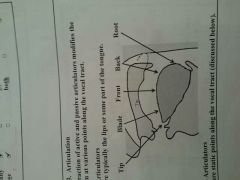
|
|
|
what is the larynx?
|
the larynx is at the top of the trachea. It is a boxlike construction of cartilage.
the protuberance at the top of larynx is Adam's apple the vocal folds are inside the larynx just below the level of the Adam's apple |
|
|
what is the oral cavity?
|
from the velum to the lips
|
|
|
what is the pharynx?
|
begins behind the velum and ends at the larynx
|
|
|
what is the vocal tract?
|
the pharynx + oral cavity
|
|
|
there are 3 resonating cavities of the head and neck, what are they?
|
1. nasal cavity (divided by oral cavity by hard palate and can be cut off or connected to the vocal tract by the action of the velum)
2. oral cavity 3. pharynx |
|
|
important parts of head and neck used in speech production
|

|
|
|
organs of speech
|
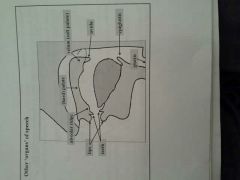
|
|
|
organs of speech
|

|
|
|
places of articulation:
Labial |
sounds formed by articulation of upper and lower lips
eg. p b m |
|
|
places of articulation:
Labio-dental |
sounds produced by the lower lip and upper incisors, the lip is the passive articulator and the upper incisors are the active articulators.
eg. f v |
|
|
places of articulation:
Dental (inter - dental) |
sounds made putting the tip of the tongue in contact with the incisors, or actually between both sets of teeth
eg. θ and ð |
|
|
places of articulation:
Alveolar |
the blade or tip and blade of the tongue touches or comes close to the alveolar ridge.
eg. n t d s z l r |
|
|
places of articulation:
post-alveolar (alveopalatal or palate - alveolar) |
blade of the tongue articulating with the junction of the alveolar ridge and the hard palate
eg. ʃ ʒ tʃ ʤ |
|
|
places of articulation:
Palatal |
the front of the tongue articulating with the hard palate
eg. j |
|
|
places of articulation:
Velar |
back of the tongue articulating with the velum (soft palate)
eg. k g ŋ |
|
|
manner of articulation
|
the degree of obstruction of airflow due to the proximity of the active and passive articulators
|
|
|
manners of articulation
|
nasal, plosives, fricatives, approximants, affricates, trills, taps and flaps
|
|
|
central vs lateral
|
describes the route the airstream takes as it passes through the oral cavity.
Except for stops, in the production of all consonantal segments, the pulmonic airstream may be central or lateral In English only l is lateral, all other segmentals are central. |
|
|
places of articulation:
Glottal |
sounds formed from the glottis
the sound associated with h in hang is a glottal sound |
|
|
what is a stop? also called plosives
|
a manner of articulation.
the articulators form an air-tight seal at some point in the oral tract; the air flow is completely obstructed. 3 stages in production of a plosive consonant: closing stage + hold stage = stop release stage = plosion Occasionally plosives may lack the closing or release stages but they ALWAYS have a HOLD stage |
|
|
what is an articulator?
|
a part of the oral cavity that is directly involved in making a speech sound.
|
|
|
why are the English nasals considered stops?
|
although air from the lungs is free to flow out through the nasal cavity, each of these sounds involves a complete obstruction at some point in the oral cavity.
|
|
|
what is a fricative?
|
manner of articulation
the active articulators come close enough to the passive ones to impede or restrict the flow of air but do not stop it completely; the air stream becomes turbulent and a audible hiss is produced. eg. f v θ ð s z ʃ ʒ h |
|
|
what is an affricate?
|
a complete obstruction is released gradually; the air, which has built up behind the obstruction squeezes through the gap creating audible friction.
English only has 2: tʃ and ʤ |
|
|
what is an approximant?
|
the vocal tract is narrowed by movement of the active articulator towards the passive one; the gap is not narrow enough to produce turbulence so no hiss.
can be divided into 2 classes: 1. liquids [l r] 2. semi vowels/glides [j w] the glides are phonetically like vowels but they behave like consonants (consonantal behaviour is shown by use of indefinite article as a before consonants and not as an as in front vowels when using j and w) |
|
|
what is a trill?
|
the active articulator is held in such a position that the airstream flowing over it causes it to vibrate rapidly against the passive one. the vocal tract is alternatively open and closed.
seen is some dialects of Scottish English eg. rabbit |
|
|
what is a flap and tap?
|
the active articulator makes a single fast contact with the passive one. in some English dialects heard when the alveolar stops are articulated as taps when between 2 vowels, the t in butter
|
|
|
list the manners of articulation
|
nasals, plosives, fricatives, affricates, approximants, trills, taps and flaps
|
|
|
how are vowels differentiated from consonants?
|
by reference to their articulation.
articulators do not touch, there is no restriction to the airfow. the airflow is voiced as it comes through the glottis. vowel sounds are produced by changes in the position of lips, tongue, and lower jaw; these changes combine to alter the shape of the oral cavity. |
|
|
vowels
|
easy to make; first sounds that babies produce
they are more mobile than consonant sounds and as a consequence, frequent indicators of variations in accent. |
|
|
what is the cardinal vowel system?
|
a reference system devised by daniel jones(english 1881-1967) for plotting the position of vowels in the mouth during their articulation.
provides a set of reference points for mapping of vowels. it visualises the centre of the mouth as a grid diagram - the dimensions of which correspond to the vowel space. |
|
|
where vowels are produced
|
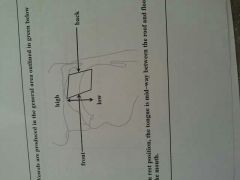
|
|
|
the standard IPA vowel chart
|
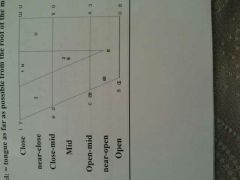
|
|
|
3 parameters are used to describe articulation of vowels
|
1. HEIGHT (vertical movement of tongue)
close/high vowel = tongue close as possible to roof of mouth open/ low vowel = tongue as far as possible from roof of mouth 2.BACKNESS (horizontal movement of tongue) front, central, back 3. ROUNDNESS (lip position) rounded or unrounded |
|
|
vowel quality is?
|
the difference between vowel sounds. differences in quality are distinctive, serves to differentiate one vowel from another
different shapes = different resonance different resonance = different vowel quality the resonant frequencies of the vocal tract are known as formants formants can be seen using a spectrograph |
|
|
vowels can be divided into?
|
MONOPHTHONGS [pure vowels] (single sound/quality of vowel remains relatively unchanged
English distinguishes up to 12 DIPHTHONGS (glides between vowel positions/vowel that is produced with continually changing quality. English distinguishes around 8 |
|
|
vowel length or quantity
|
all vowels are either short or long
in modern English differences in quantity are not distinctive (they do not result in phonemic contrasts) |
|
|
short vowels
|
also referred to as lax - since they involve less tense articulation of the vocal organs
also referred to as checked = meaning they can only occur in a closed syllable (those which have a coda, unless the syllable is unstressed) |
|
|
list long vowels in english
|
monophthongs
i: bead ɑ: bard ɜ: bird, burn ɔ: saw, bought u: booed all diphthongs are long. |
|
|
diphthongs
|
if the sound continually changes within a single syllable then it is a diphthong.
a diphthong moves from a starting position to a finishing position (represented by a digraph, with a start point, an end point and an arrow to show continuous production) |
|
|
diphthongs
|
can be classified as opening, closing or centring.
opening = the mouth opens during their production closing = mouth moves to a closer position centring = the final element on the diphthong is a central vowel |
|
|
what is the process of breaking?
|
long vowels can, over time, develop into diphthongs
|
|
|
what is the process of smoothing?
|
diphthongs can become long monophthongs
|
|
|
what is a triphthong?
|
a group of vowel sounds that typically combine a diphthong and a monophthong together.
(these combinations occur systematically enough to identify them separately) they are a glide from one vowel to another and then to a third each one ends in SCHWA. this means that the diphthongs that already end in schwa do not extend to form triphthongs. /ɛɪə/ player /ɑɪə/ fire /ɔɪə/ royal |
|
|
what is this symbol?
ə |
schwa also shwa
this is the most frequent vowel phoneme in English a weak and unstressed vowel produced from the central area of the mouth frequently occurs in small function words like: the, and, for especially in running speech |
|
|
what is reduction?
|
when a weaker vowel (usually ə, sometimes ɪ or ʊ ) is substituted in place of a stronger one
frequently happens in connected speech where many monosyllabic words (to for and the) are lightly stressed also occurs in polysyllabic words in those syllables that are unstressed. |
|
|
what is elision?
|
the omission of a phoneme in speech. Words such as handsome and mostly are frequently pronounced without /d/ and /t/
elision is common in casual speech styles, particularly at word boundaries. the most frequently elided consonants are /t/ and /d/ |
|
|
what is a diacritic?
|
a mark or symbol that indicates the pronunciation value of a speech segment.
they are predominantly used in conjunction with the phoneme symbols from the IPA to indicate allophonic variants. some letters of the conventional alphabet can also function diacritically. eg. e at the end of some monosyllables din and dine - the silent e lets us know the previous vowel is a diphthong rather than a short vowel. |
|
|
list all voiceless consonants in English
|
/p/ /t/ /k/ STOPS
/f/ /θ/ /s/ /ʃ/ /h/ FRICATIVES /tʃ/ AFFRICATE |
|
|
LIST all stops in ENGLISH
|
/p/ /b/ /t/ /d/ /k/ /g/ oral stops
/m/ /n/ /ŋ/ nasal stops |
|
|
list all fricatives in english
|
/f/ /v/ labio - dental
/θ/ /ð/ dental /s/ /z/ alveolar /ʃ/ /ʒ/ post - alveolar /h/ glottal |
|
|
list all affricates in english
|
/tʃ/ and /ʤ/ both are post-alveolar
/tʃ/ is voiceless /ʤ/ is voiced |
|
|
list all approximants in english
|
/w/ /l/ /r/ /j/
w is labio velar l is alveolar lateral r is alveolar j is palatal l and r are LIQUIDS w and j are GLIDES (semi-vowels) |
|
|
english consonants
|
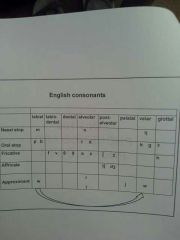
|

